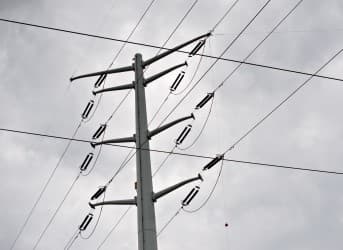Barring an unlikely change of heart by the U.S. Congress, the U.S. Energy Department believes natural gas and coal will continue to provide the bulk of electricity to the nation's grid in the years ahead, despite a projected increase in renewable energy.
The U.S. Energy Information Administration (EIA), the statistical arm of the Energy Department, said it expects renewable electricity generation to increase steadily in the coming decades even without any major overhaul to tax or regulatory policy.
Despite the increase, under the same scenario, coal will still account for 32 percent and natural gas will account for 35 percent of the electricity generated for the U.S. grid by 2040.
U.S. President Barack Obama outlined his so-called “all of the above” energy policy more than two years ago, saying that existing strategies were based on outdated models for a secure energy future. Under his plan, there should be enough renewable electricity programs permitted to meet the annual energy demands of 6 million homes by 2020.
On April 28, the Energy Department said it was exploring ways to generate electricity from ocean waves through a $10 million test program in Hawaii. Last week, it said $15 million has been set aside to help communities develop solar energy strategies. Installed solar energy already provides more than 13 gigawatts of power to the grid, according to the department.
But EIA says those efforts may not be enough to put renewable energy on par with conventional power sources, assuming current laws on the books expire, technology remains the same and demographic trends are static.
Related Article: A Polluted Superfund Site Is Now Home To 36,000 Solar Panels
If existing policies supporting renewable energy aren’t allowed to expire, however, renewable energy will account for nearly a quarter of the electricity generated by 2040, EIA said.
Mike Prior, executive director of the Iowa Wind Energy Association, wrote in “The Hill” newspaper last week that production tax credits for renewable resources are the "de facto energy policy" in the United States. Without them, he said, the formula for a low-carbon success is in jeopardy.
Energy industry groups with deep pockets are lobbying Congress to turn away from renewable energy, and so far, they’re winning; in March, the House of Representatives passed a bill aimed at blocking Obama’s so-called war on coal.
ADVERTISEMENT
In his State of the Union address earlier this year, Obama said one home or business adopts solar energy as an alternative every four minutes. Policies that give the fossil fuels incentives over renewables, he said, don't make sense. Given EIA projections, however, a business-as-usual plan will keep low-carbon alternatives at a minimum in the U.S. energy mix.
By Daniel J. Graeber of Oilprice.com



















My last two electric bills were $7.21 and that includes about 700 miles a month in my electric vehicle. Once you have experienced the freedom and driving of an EV you will never go back.